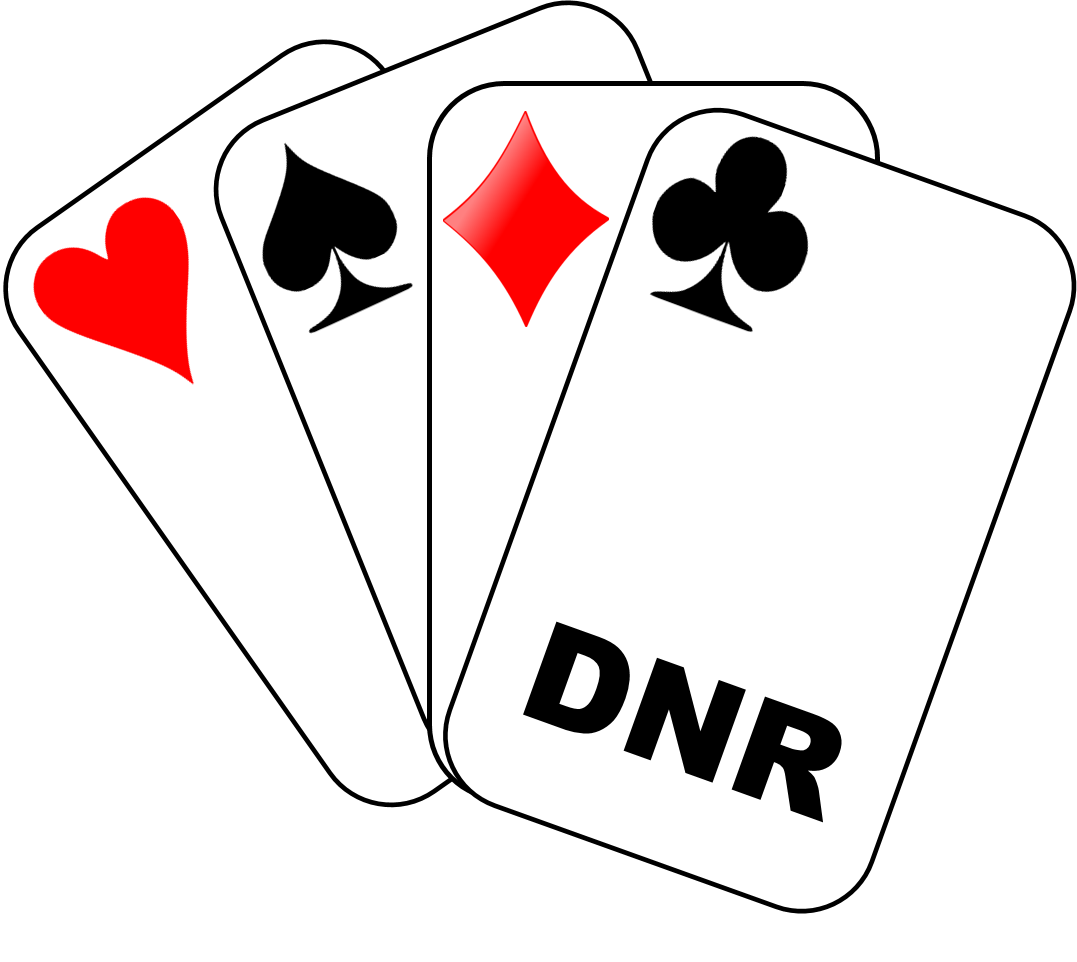Kirwan League Team of 4 Instructions –
Face to Face Matches
Introduction
Kirwan League Team matches consist of 24 board matches (20 boards for Novices)
which may be played “face to face” or “online on BBO”. It is up to the team captains to
agree which method is suitable, although the Home Team Captain has final say over
which method is most suitable. This document outlines how to go about setting up a
“Face to Face” match and how to score the match. The Home Team is responsible for
providing the venue for the match. They must ensure that they have two tables which
are sufficiently far apart so that game discussions cannot be overheard. They should
have 4 bidding boxes for each table and 24 boards (20 boards for a Novice Match). A
match will consist of two sessions. Boards 1 to 12 will be played in Session 1 and
Boards 13 to 24 will be played in Session 2 (For Novice Matches Boards 1 to 10 will be
played in Session 1 and Boards 11 to 20 will be played in Session 2.)
Before Match Starts
The home team as hosts should ensure that there are two table available for the match
at their bridge club that are sufficiently distant from each other, so that
bidding/discussions cannot be overheard. Two copies of the “24 Board Result Sheet –
Table 1” should be placed on Table 1 and two copies of “24 Board Result Sheet – Table
2” should be placed on Table 2. (Note the “20 Board Result Sheet – Table 1” and “20
Board Result Sheet – Table 2 should be used for Novice matches or where you do not
have time to play a 24 board match.) One copy is to be used by the North/South pair on
each table and the other copy is to be used by the East/West pair on each table. (Note –
When a pair from the Away Team moves table after Session 1, they should leave the
copy of the Result Sheet at the table so that the other pair from the Away Team can
continue to use it to record the 2nd Session details.)
Session 1 Preparation and Play
Place Boards 1 to 6 on Table 1 and Boards 7 to 12 on Table 2 (For Novice Matches, place
boards 1 to 5 on Table 1 and Boards 6 to 10 on Table 2.) Pair 1 from the Home Team will
play North/South and Pair 1 from the Away Team will play East/West on Table 1. Pair 2
from the Home Team will play East/West and Pair 2 from the Away Team will play
North/South on Table 2. Each Pair on each table should update their respective
Table Result Sheet as follows:
1. Enter the COMPETITION NAME such as “Inter B Kirwan League – Round 1
2. Enter the Home Team Name
3. Enter the Away Team Name
4. Name of player playing North in Session 1
5. Name of player playing South in Session 1
6. Name of player playing East in Session 1
7. Name of player playing West in Session 1
If the boards are not pre dealt, then the pairs should deal the boards on each of their
tables. Once dealt boards are available, then the pairs should play the six boards on
their table. When these are complete, they should exchange boards with the other table
and then play the remaining 6 boards. Session 1 is deemed to be complete when
boards 1 to 12 have been played on both tables. (Boards 1 to 10 in a Novice Match).
Scoring a Board
When each board is complete each pair should agree and record the result on their
respective Result Sheets:
1. Contract – They should record the contract and result in this column. For
example, if the contract was 3NT and 9 tricks were made, then enter 3NT; if only
8 tricks were made, then enter 3NT-1; if 11 tricks were made, then enter 3NT+2
2. By – Enter which player played the contract – N, S, E or W
3. N/S + If North/South played and made the contract or if East/West played the
contract and did not make it, then enter the score in the N/S + column. (You will
find the relevant scores at the back of the bidding card for the final contract)
4. N/S - If North/South played the contract and did not make it or if East/West
played and made the contract, then enter the score in the N/S - column.
Session 2 Preparation and Play
Place Boards 13 to 18 on Table 1 and Boards 19 to 24 on Table 2 (For Novice Matches,
place boards 11 to 15 on Table 1 and Boards 16 to 20 on Table 2.) Pair 1 from the Home
Team will continue to play North/South on Table 1, but Pair 2 from the Away Team will
move from Table 2 to play East/West on Table 1. Pair 2 from the Home Team will
continue to play East/West on Table 2, but Pair 1 from the Away Team will move from
Table 1 to play North/South on Table 2.
Each Pair on each table should update their respective Table Result Sheet as follows:
1. Name of player playing North in Session 2
2. Name of player playing South in Session 2
3. Name of player playing East in Session 2
4. Name of player playing West in Session 2
If the boards are not pre dealt, then the pairs should deal the boards on each of their
tables. Once dealt boards are available, then the pairs should play the six boards on
their table. When these are complete, they should exchange boards with the other table
and then play the remaining 6 boards. Continue to score each board as set out above.
Session 2 and the match is deemed to be complete when boards 13 to 24 have been
played on both tables. (Boards 11 to 20 in a Novice Match).
How to Calculate Match Points for each Board Played
We use Match Points (also known as IMPS - International Match Points) to determine
the winners of a team match. For each board played we must calculate the number of
match points won or lost by each team. This is always done from the point of view of the
North/South team. Firstly, though we must calculate the Net N/S Score for the team
and then we must convert the Net N/S Score to IMPS by using the following conversion
table:

For example, if the Net N/S Score is +200, then this converts to +5 IMPs for a team,
while if the Net N/S Score is –200, then this converts to –5 IMPs for a team.
The Home Team (North/South on Table 1) should use the result sheet from Table 1 and
compare their results against the result sheet where their partners (East/West on Table
2) recorded the board results for Table 2. Similarly, the Away Team (North/South on
Table 2) should compare their results against the result sheet where their partners
(East/West on Table 1) recorded the board results for Table 1.
There are four possible scenarios when calculating Net N/S Score. We will look at each of these scenarios where one pair plays N/S and the other pair plays East/West.
Scenario 1 – N/S make a positive score on one table (the N/S +
Column) and their partners who play E/W on the other table also make
a positive score (the N/S - Column)
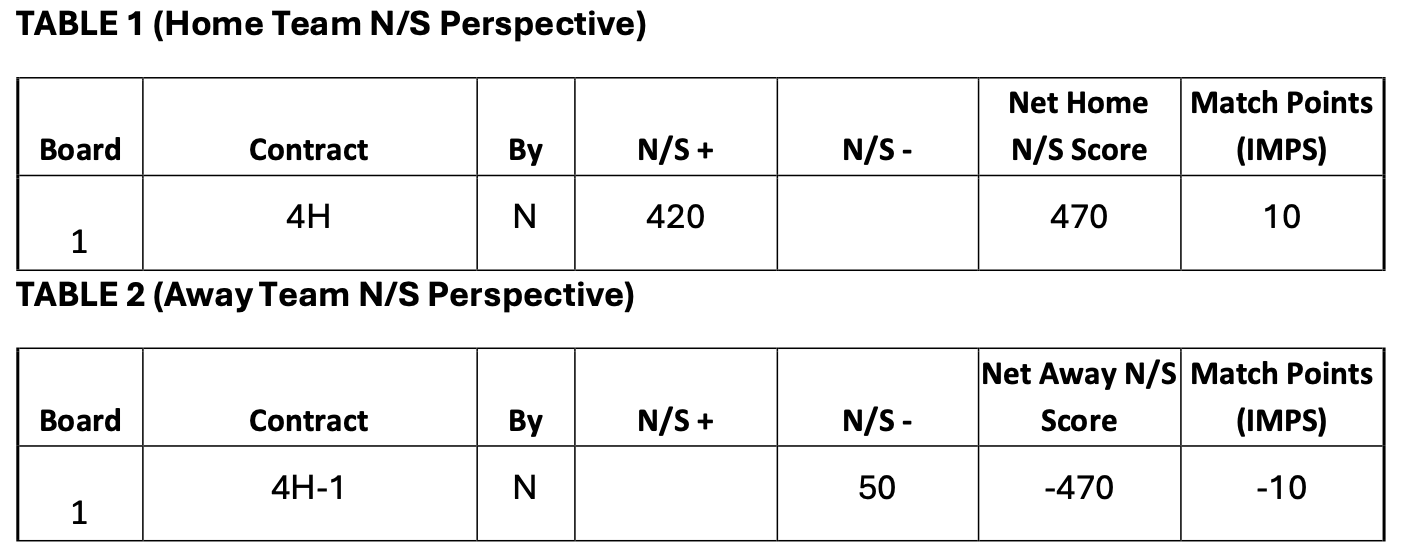
If we look at this from the Home Team’s point of view, on Table 1, N/S made their
contract of 4H for a score of 420 in the N/S + column, while on Table 2, their partners –
Pair 2 defeated the opposition 4H contract by 1 trick and scored 50 for their team which
was recorded in the N/S - Column. The Home Team Net N/S Score is 470 (Table 1 N/S +
Score (420) + Table 2 N/S - Score (50)). We use the IMP Conversion Table above and
find that a Net N/S Score of 470 results in an IMP Score of 10. The corollary of this for
the opposing team (N/S on Table 2) is an IMP Score of –10.
The following is another example of this type of scenario:
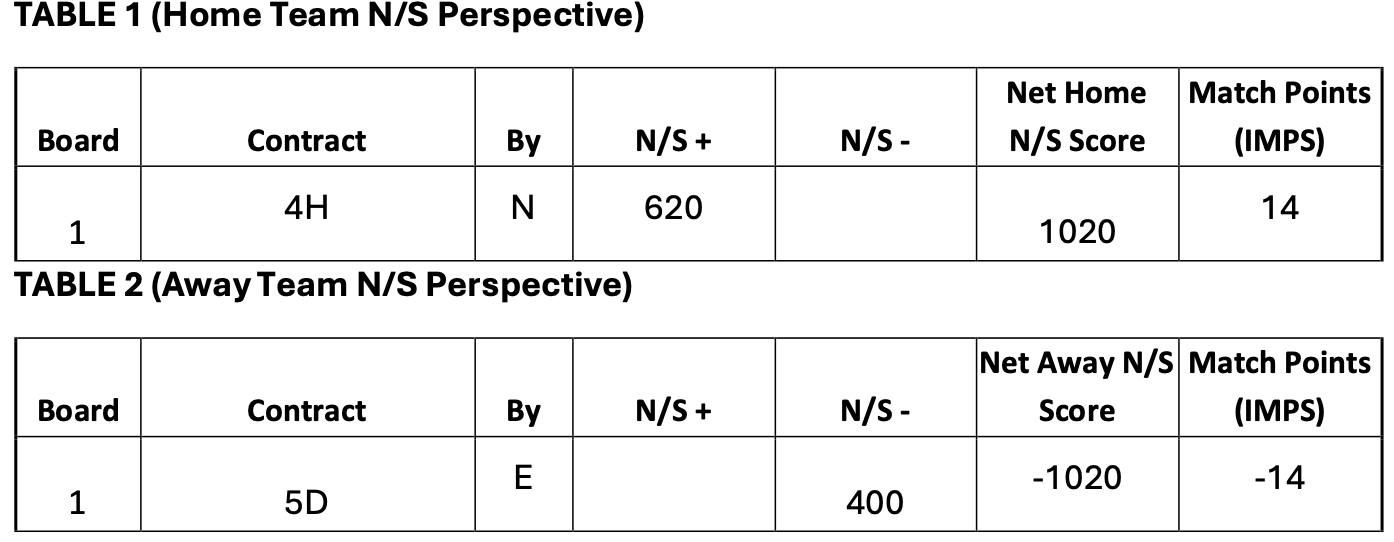
Here N/S on Table 1 again make a vulnerable 4H for a score of 620, and their partners
playing E/W on Table 2 outbid the opposition by bidding and making 5D resulting in a 14
IMP swing for their team.
Scenario 2 – N/S make a negative score on one table (the N/S -
Column) and their partners who play E/W on the other table also make
a negative score (the N/S + Column)
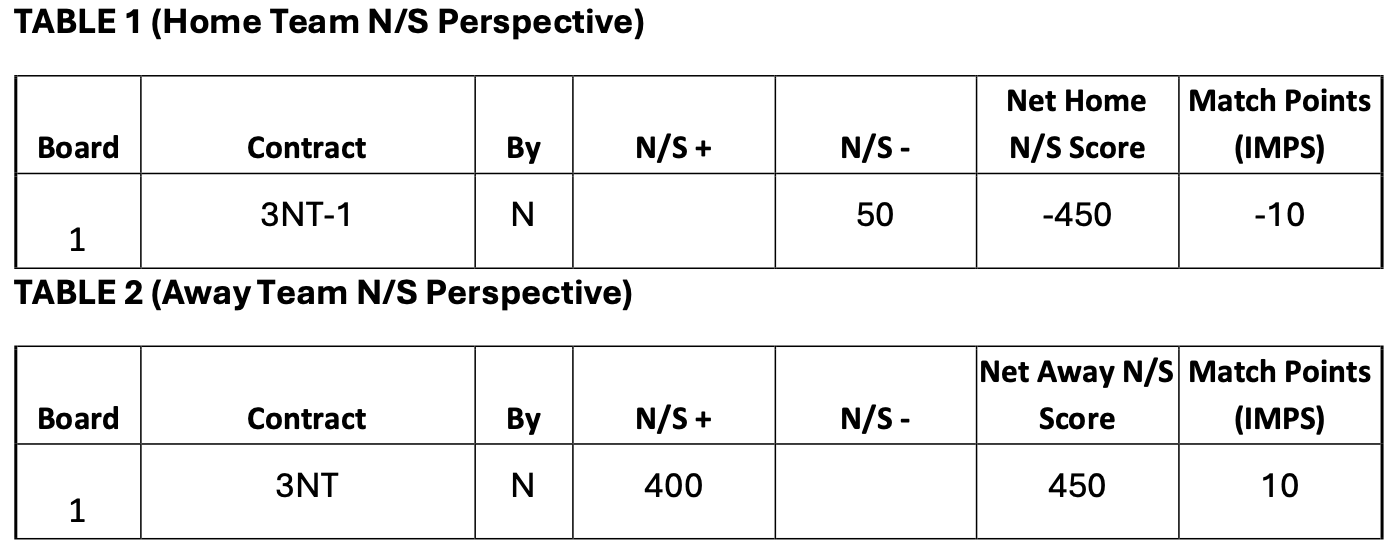
If we look at this from the Home Team’s point of view, on Table 1, N/S went down one in
their contract of 3NT for a score of 50 in the N/S - column, while on Table 2, their
partners – Pair 2 allowed the opposition to make 3NT resulting in a score of –400 for
their team which was recorded in the N/S - Column. The Home Team Net N/S Score is -
450 (- Table 1 N/S - Score (50) - Table 2 N/S + Score (400)). Again, we use the IMP
Conversion Table above and find that a Net N/S Score of -450 results in an IMP Score of
-10. The corollary of this for the opposing team (N/S on Table 2) is an IMP Score of 10.
The following is another example of this type of scenario:
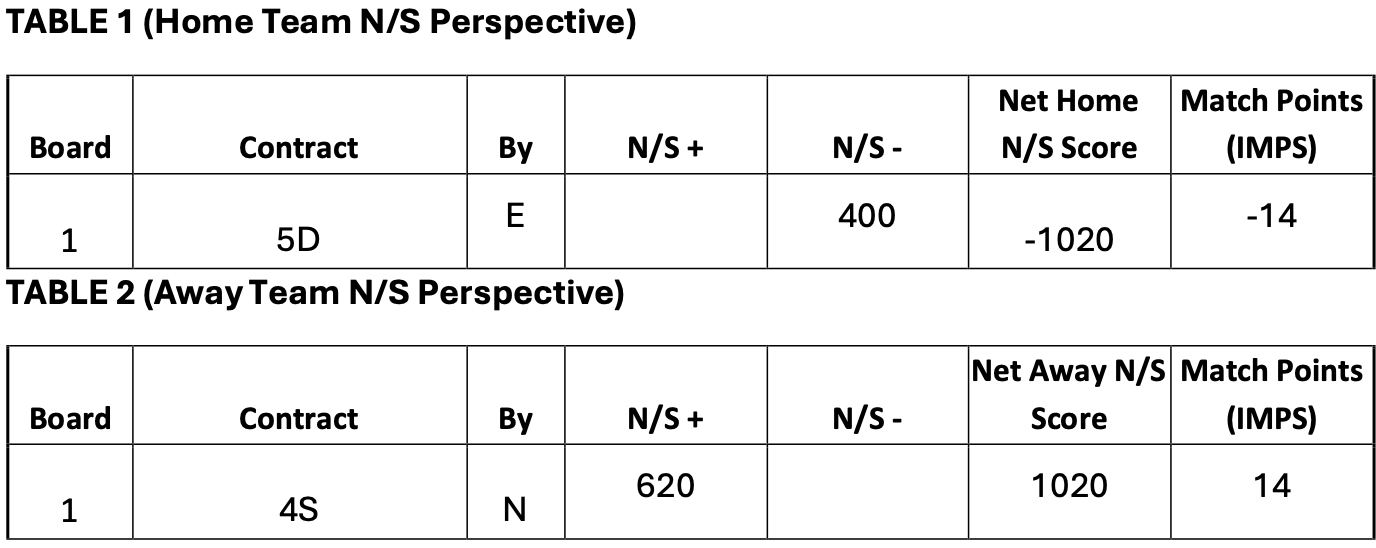
Here N/S on Table 1 were outbid by their E/W opponents who made a non-vulnerable
5D for a score of 400, and their partners playing E/W on Table 2 did not bid 5D but
allowed the opposition to make a vulnerable 4S resulting in a 14 IMP swing to the
opposition.
Scenario 3 – N/S make a positive score on one table (the N/S +
Column) and their partners who play E/W on the other table allow
Opposition N/S to also make a positive score (the N/S + Column)
There are 3 sub scenarios here:
1. The N/S + Score on Table 1 is greater than that on Table 2
2. The N/S + Score on Table 1 is less than that on Table 2
3. The N/S + Score on Table 1 equals that on Table 2
Scenario 3.1 The N/S + Score on Table 1 is greater than that on Table 2
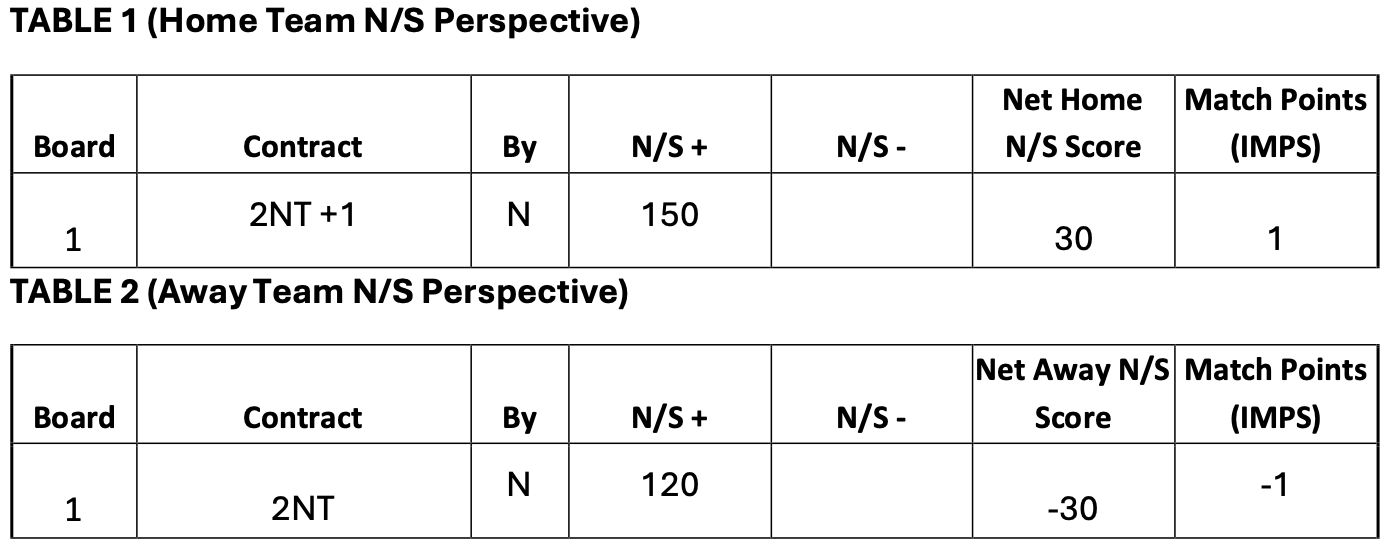
If we look at this from the Home Team’s point of view, on Table 1, N/S makes 2NT+1 for
a score of 150 in the N/S + column, while on Table 2, their partners – Pair 2 held the
opposition to 2NT resulting in a score of 120 for the opposition which was recorded in
the N/S + Column. The Home Team Net N/S Score is 30 (Table 1 N/S + Score (150) -
Table 2 N/S + Score (120)). Again, we use the IMP Conversion Table above and find that
a Net N/S Score of 30 results in an IMP Score of 1. The corollary of this for the opposing
team (N/S on Table 2) is an IMP Score of -1.
Scenario 3.2 The N/S + Score on Table 2 is less than that on Table 2
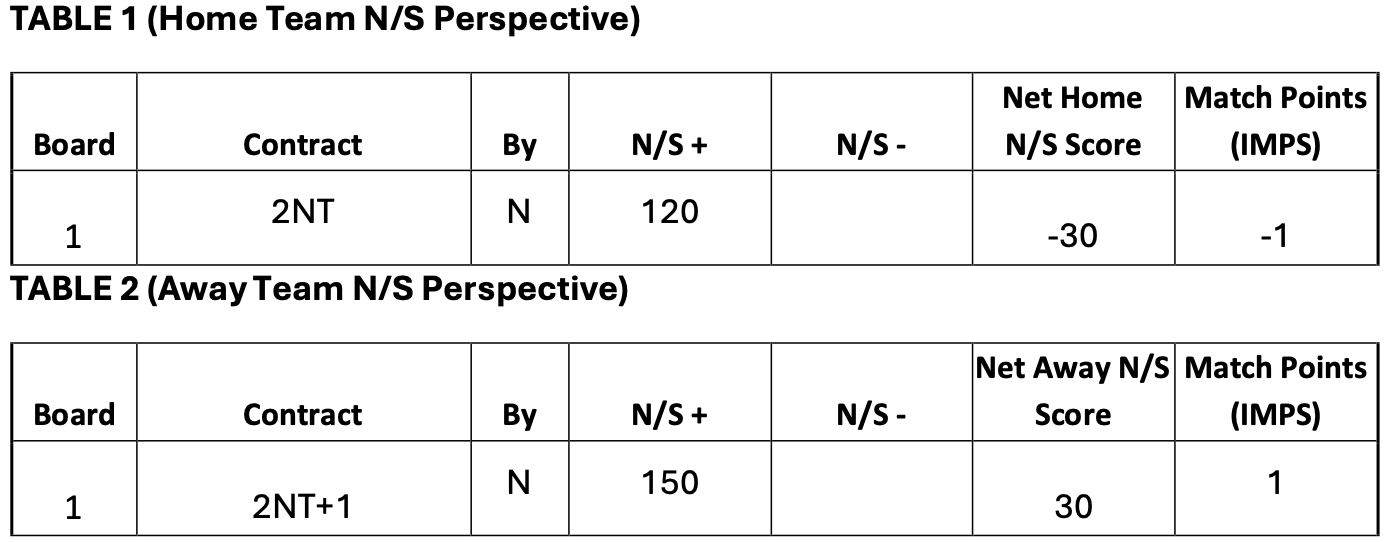
If we look at this from the Home Team’s point of view, on Table 1, N/S only make 2NT for
a score of 120 in the N/S + column, while on Table 2, their partners – Pair 2 allow the
opposition to make 2NT +1 resulting in a score of 150 for the opposition which was
recorded in the N/S + Column. The Home Team Net N/S Score is -30 (Table 1 N/S +
Score (120) - Table 2 N/S + Score (150)). Again, we use the IMP Conversion Table above
and find that a Net N/S Score of -30 results in an IMP Score of -1. The corollary of this for
the opposing team (N/S on Table 2) is an IMP Score of 1.
Scenario 3.3 The N/S + Score on Table 1 equals that on Table 2
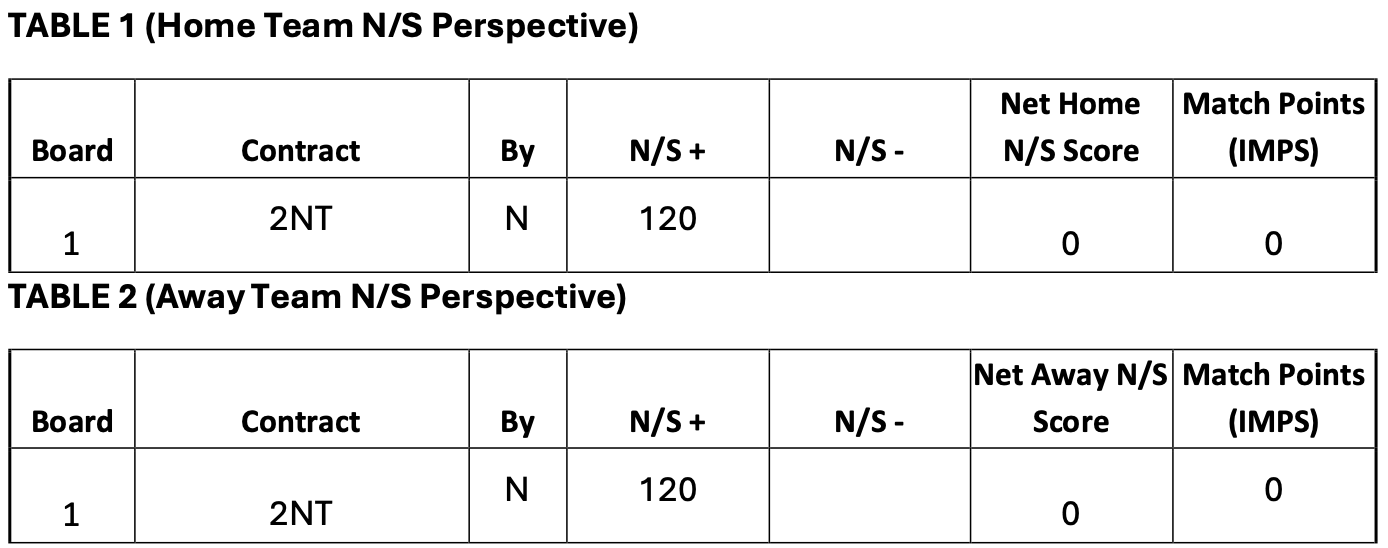
If we look at this from the Home Team’s point of view, on Table 1, N/S makes 2NT for a
score of 120 in the N/S + column and on Table 2, their partners – Pair 2 also hold the
opposition to 2NT resulting in a score of 120 for the opposition which was recorded in
the N/S + Column. The Home Team Net N/S Score is 0 (Table 1 N/S + Score (120) -
Table 2 N/S + Score (120)). The IMP Score Conversion shows that where the difference
between the two teams is 0 to 10, then the IMP Score is 0.
Scenario 4 – N/S make a minus score on one table (the N/S - Column)
and their partners who play E/W on the other table get the better of
opposition N/S to get a positive score for their team (the N/S -
Column)
There are 3 sub scenarios here:
1. The N/S - Score on Table 1 is greater than that on Table 2.
2. The N/S - Score on Table 1 is less than that on Table 2
3. The N/S - Score on Table 1 equals that on Table 2
Scenario 4.1 The N/S - Score on Table 1 is greater than that on Table 2
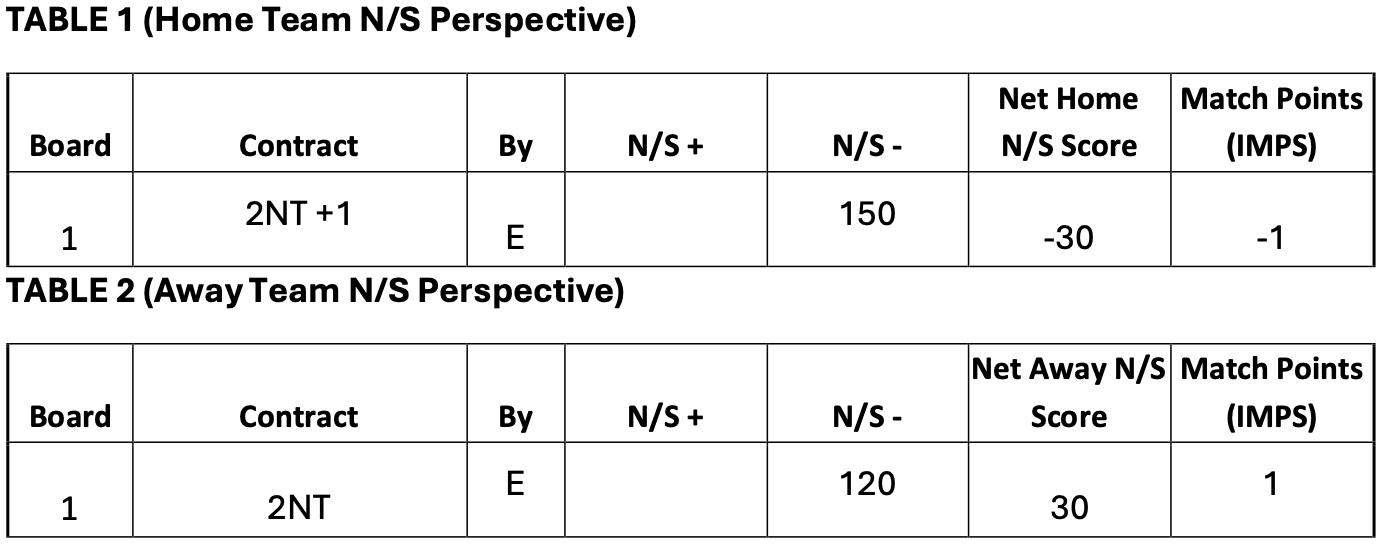
If we look at this from the Home Team’s point of view, on Table 1, N/S allows their E/W
opponents to make 2NT+1 for a score of 150 in the N/S - column, while on Table 2, their
partners – Pair 2 playing E/W only make 2NT resulting in a score of 120 which was
recorded in the N/S - Column. The Home Team Net N/S Score is -30 (- Table 1 N/S -
Score (150) +Table 2 N/S - Score (120)). Again, we use the IMP Conversion Table above
and find that a Net N/S Score of -30 results in an IMP Score of -1. The corollary of this for
the opposing team (N/S on Table 2) is an IMP Score of 1.
Scenario 4.2 The N/S - Score on Table 2 is less than that on Table 2
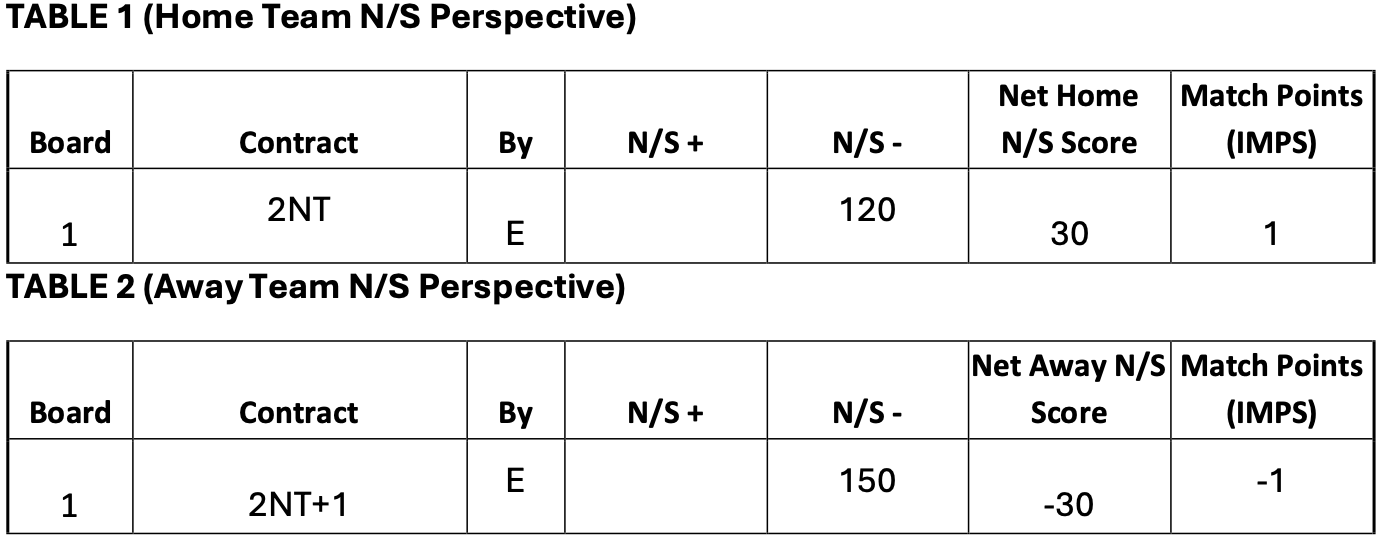
If we look at this from the Home Team’s point of view, on Table 1, N/S hold the
opposition E/W to 2NT for a score of 120 in the N/S - column, while on Table 2, their
partners – Pair 2 playing E.W make 2NT +1 resulting in a score of 150 which was
recorded in the N/S - Column. The Home Team Net N/S Score is 30 (- Table 1 N/S -
Score (120) + Table 2 N/S - Score (150)). Again, we use the IMP Conversion Table above
and find that a Net N/S Score of 30 results in an IMP Score of 1. The corollary of this for
the opposing team (N/S on Table 2) is an IMP Score of -1.
Scenario 4.3 The N/S - Score on Table 1 equals that on Table 2

If we look at this from the Home Team’s point of view, on Table 1, N/S allows the
opposition E/W to make 2NT for a score of 120 in the N/S - column and on Table 2, their
partners – Pair 2 playing E/W also make 2NT resulting in a score of 120 for their team
which was recorded in the N/S - Column. The Home Team Net N/S Score is 0 (- Table 1
N/S - Score (120) + Table 2 N/S - Score (120)). The IMP Score Conversion shows that
where the difference between the two teams is 0 to 10, then the IMP Score is 0.
Summary of Board Scoring Scenarios in a Team Match from a N/S
Perspective
Scenario 1 – N/S make a positive score on one table (the N/S + Column)
and their partners who play E/W on the other table also make a positive
score (the N/S - Column)
(Table 1 N/S + Score plus Table 2 N/S - Score).
Scenario 2 – N/S make a negative score on one table (the N/S - Column)
and their partners who play E/W on the other table also make a negative
score (the N/S + Column)
(minus Table 1 N/S - Score minus Table 2 N/S + Score)
Scenario 3 – N/S make a positive score on one table (the N/S + Column)
and their partners who play E/W on the other table allow Opposition N/S to
also make a positive score (the N/S + Column)
(Table 1 N/S + Score minus Table 2 N/S + Score)
Scenario 4 – N/S make a minus score on one table (the N/S - Column) and
their partners who play E/W on the other table get the better of opposition
N/S to get a positive score for their team (the N/S - Column)
(minus Table 1 N/S - Score plus Table 2 N/S - Score)
How to Complete the Result Sheet when all the Boards have been
Scored
Table 1 Result Sheet – Calculate Total Match Points for Home Team and
Away Team
The Home Team Captain should do the following:
1. Total the “+” Scores in the Match Point Column for Session 1 and record the
total in N/S Total (Total of '+' Match Points) in the Session 1 section of the
Results Sheet.
2. Total the “-” Scores in the Match Point Column for Session 1 and record the total
in E/W Total (Total of '-' Match Points) in the Session 1 section of the Results
Sheet.
3. Total the “+” Scores in the Match Point Column for Session 2 and record the
total in N/S Total (Total of '+' Match Points) in the Session 2 section of the
Results Sheet.
4. Total the “-” Scores in the Match Point Column for Session 2 and record the total
in EW Total (Total of '-' Match Points) in the Session 2 section of the Results
Sheet.
5. Total the Home Team’s Session 1 and Session 2 N/S Total (Total of '+' Match
Points) and record the total in the “Home Team Match Points Total” at the top of
the Results Sheet.
6. Total the Away Team’s Session 1 and Session 2 E/W Total (Total of '-’ Match
Points) and record the total in the “Away Team Match Points Total” at the top of
the Results Sheet.
Table 1 Result Sheet – Calculate Victory Points for Home Team and Away
Team
To calculate the final result of the Match, we must do another conversion. We need to
calculate the difference in Match Points between the Home Team and the Away Team
and then use the Victory Points Scales to work out the final Victory Points for both
teams.
The Home Team Captain should do the following:
1. Calculate the Match Point Margin between Home Team and the Away Team by
subtracting the “Away Team Match Points Total” from the “Home Team Match Points
Total”
2. Using the Match Point Margin, look up the 24 Board Continuous Victory Point
Scale or 20 Board Continuous Victory Point Scale at
https://www.ebu.co.uk/laws-and-ethics/vp-scales
For example, if the Home Team won by a margin of 20 Match Points, then
when we look up the 24 Board Continuous Victory Point Scale this gives a
result of 14.26 - 5.74, which means that the Home Team have scored
14.26 Victory Points and the Away Team have scored 5.74 Victory Points.
On the other hand, if the Home Team lost by 20 Match Points, then the
Home Team will have scored 5.74 Victory Points and the Away Team
will have scored 14.26 Victory Points.
3. Record the Victory Points for both the Home Team and the Away Team on the
Results Sheet.
Table 2 Result Sheet – Calculate Total Match Points for Away Team and
Home Team
The Away Team Captain should do the following:
1. Total the “+” Scores in the Match Point Column for Session 1 and record the
total in N/S Total (Total of '+' Match Points) in the Session 1 section of the
Results Sheet.
2. Total the “-” Scores in the Match Point Column for Session 1 and record the total
in E/W Total (Total of '-' Match Points) in the Session 1 section of the Results
Sheet.
3. Total the “+” Scores in the Match Point Column for Session 2 and record the
total in N/S Total (Total of '+' Match Points) in the Session 2 section of the
Results Sheet.
4. Total the “-” Scores in the Match Point Column for Session 2 and record the total
in EW Total (Total of '-' Match Points) in the Session 2 section of the Results
Sheet.
5. Total the Away Team’s Session 1 and Session 2 N/S Total (Total of '+' Match
Points) and record the total in the “Away Team Match Points Total” at the top of
the Results Sheet.
6. Total the Home Team’s Session 1 and Session 2 E/W Total (Total of '-’ Match
Points) and record the total in the “Home Team Match Points Total” at the top of
the Results Sheet.
Table 2 Result Sheet – Calculate Victory Points for Away Team and Home
Team
To calculate the final result of the Match, we must do another conversion. We need to
calculate the difference in Match Points between the Away Team and the Home Team
and then use the Victory Points Scales to work out the final Victory Points for both
teams.
The Away Team Captain should do the following:
1. Calculate the Match Point Margin between Away Team and the Home Team by
subtracting the “Home Team Match Points Total” from the “Away Team Match Points
Total”
2. Using the Match Point Margin, look up the 24 Board Continuous Victory Point
Scale or 20 Board Continuous Victory Point Scale at
https://www.ebu.co.uk/laws-and-ethics/vp-scales
For example, if the Away Team won by a margin of 20 Match Points, then
when we look up the 24 Board Continuous Victory Point Scale this gives a
result of 14.26 - 5.74, which means that the Away Team have scored
14.26 Victory Points and the Home Team have scored 5.74 Victory Points.
On the other hand, if the Away Team lost by 20 Match Points, then the
Away Team will have scored 5.74 Victory Points and the Home Team
will have scored 14.26 Victory Points.
3. Record the Victory Points for both the Away Team and the Home Team on the
Results Sheet.
The Final Steps
If you have got this far – played 24 boards and managed to score them, you are probably
exhausted, but there are a few more steps. Firstly, the Home and Away Team Captains
should compare their results sheets. If they have both got the same Victory Point
Scores for their teams, then all they have to do is take photos of both their Table 1 and
Table 2 sets of score sheets and send them on to their Kirwan League Co-ordinator,
who will check them and update the League Tables. However, if there is a difference
between their score sheets, they will need to investigate and correct whichever one is
wrong before forwarding their scoresheets to the co-ordinator.
Dan O'Mahony
Face to Face Matches
Introduction
Kirwan League Team matches consist of 24 board matches (20 boards for Novices)
which may be played “face to face” or “online on BBO”. It is up to the team captains to
agree which method is suitable, although the Home Team Captain has final say over
which method is most suitable. This document outlines how to go about setting up a
“Face to Face” match and how to score the match. The Home Team is responsible for
providing the venue for the match. They must ensure that they have two tables which
are sufficiently far apart so that game discussions cannot be overheard. They should
have 4 bidding boxes for each table and 24 boards (20 boards for a Novice Match). A
match will consist of two sessions. Boards 1 to 12 will be played in Session 1 and
Boards 13 to 24 will be played in Session 2 (For Novice Matches Boards 1 to 10 will be
played in Session 1 and Boards 11 to 20 will be played in Session 2.)
Before Match Starts
The home team as hosts should ensure that there are two table available for the match
at their bridge club that are sufficiently distant from each other, so that
bidding/discussions cannot be overheard. Two copies of the “24 Board Result Sheet –
Table 1” should be placed on Table 1 and two copies of “24 Board Result Sheet – Table
2” should be placed on Table 2. (Note the “20 Board Result Sheet – Table 1” and “20
Board Result Sheet – Table 2 should be used for Novice matches or where you do not
have time to play a 24 board match.) One copy is to be used by the North/South pair on
each table and the other copy is to be used by the East/West pair on each table. (Note –
When a pair from the Away Team moves table after Session 1, they should leave the
copy of the Result Sheet at the table so that the other pair from the Away Team can
continue to use it to record the 2nd Session details.)
Session 1 Preparation and Play
Place Boards 1 to 6 on Table 1 and Boards 7 to 12 on Table 2 (For Novice Matches, place
boards 1 to 5 on Table 1 and Boards 6 to 10 on Table 2.) Pair 1 from the Home Team will
play North/South and Pair 1 from the Away Team will play East/West on Table 1. Pair 2
from the Home Team will play East/West and Pair 2 from the Away Team will play
North/South on Table 2. Each Pair on each table should update their respective
Table Result Sheet as follows:
1. Enter the COMPETITION NAME such as “Inter B Kirwan League – Round 1
2. Enter the Home Team Name
3. Enter the Away Team Name
4. Name of player playing North in Session 1
5. Name of player playing South in Session 1
6. Name of player playing East in Session 1
7. Name of player playing West in Session 1
If the boards are not pre dealt, then the pairs should deal the boards on each of their
tables. Once dealt boards are available, then the pairs should play the six boards on
their table. When these are complete, they should exchange boards with the other table
and then play the remaining 6 boards. Session 1 is deemed to be complete when
boards 1 to 12 have been played on both tables. (Boards 1 to 10 in a Novice Match).
Scoring a Board
When each board is complete each pair should agree and record the result on their
respective Result Sheets:
1. Contract – They should record the contract and result in this column. For
example, if the contract was 3NT and 9 tricks were made, then enter 3NT; if only
8 tricks were made, then enter 3NT-1; if 11 tricks were made, then enter 3NT+2
2. By – Enter which player played the contract – N, S, E or W
3. N/S + If North/South played and made the contract or if East/West played the
contract and did not make it, then enter the score in the N/S + column. (You will
find the relevant scores at the back of the bidding card for the final contract)
4. N/S - If North/South played the contract and did not make it or if East/West
played and made the contract, then enter the score in the N/S - column.
Session 2 Preparation and Play
Place Boards 13 to 18 on Table 1 and Boards 19 to 24 on Table 2 (For Novice Matches,
place boards 11 to 15 on Table 1 and Boards 16 to 20 on Table 2.) Pair 1 from the Home
Team will continue to play North/South on Table 1, but Pair 2 from the Away Team will
move from Table 2 to play East/West on Table 1. Pair 2 from the Home Team will
continue to play East/West on Table 2, but Pair 1 from the Away Team will move from
Table 1 to play North/South on Table 2.
Each Pair on each table should update their respective Table Result Sheet as follows:
1. Name of player playing North in Session 2
2. Name of player playing South in Session 2
3. Name of player playing East in Session 2
4. Name of player playing West in Session 2
If the boards are not pre dealt, then the pairs should deal the boards on each of their
tables. Once dealt boards are available, then the pairs should play the six boards on
their table. When these are complete, they should exchange boards with the other table
and then play the remaining 6 boards. Continue to score each board as set out above.
Session 2 and the match is deemed to be complete when boards 13 to 24 have been
played on both tables. (Boards 11 to 20 in a Novice Match).
How to Calculate Match Points for each Board Played
We use Match Points (also known as IMPS - International Match Points) to determine
the winners of a team match. For each board played we must calculate the number of
match points won or lost by each team. This is always done from the point of view of the
North/South team. Firstly, though we must calculate the Net N/S Score for the team
and then we must convert the Net N/S Score to IMPS by using the following conversion
table:

For example, if the Net N/S Score is +200, then this converts to +5 IMPs for a team,
while if the Net N/S Score is –200, then this converts to –5 IMPs for a team.
The Home Team (North/South on Table 1) should use the result sheet from Table 1 and
compare their results against the result sheet where their partners (East/West on Table
2) recorded the board results for Table 2. Similarly, the Away Team (North/South on
Table 2) should compare their results against the result sheet where their partners
(East/West on Table 1) recorded the board results for Table 1.
There are four possible scenarios when calculating Net N/S Score. We will look at each of these scenarios where one pair plays N/S and the other pair plays East/West.
Scenario 1 – N/S make a positive score on one table (the N/S +
Column) and their partners who play E/W on the other table also make
a positive score (the N/S - Column)

If we look at this from the Home Team’s point of view, on Table 1, N/S made their
contract of 4H for a score of 420 in the N/S + column, while on Table 2, their partners –
Pair 2 defeated the opposition 4H contract by 1 trick and scored 50 for their team which
was recorded in the N/S - Column. The Home Team Net N/S Score is 470 (Table 1 N/S +
Score (420) + Table 2 N/S - Score (50)). We use the IMP Conversion Table above and
find that a Net N/S Score of 470 results in an IMP Score of 10. The corollary of this for
the opposing team (N/S on Table 2) is an IMP Score of –10.
The following is another example of this type of scenario:

Here N/S on Table 1 again make a vulnerable 4H for a score of 620, and their partners
playing E/W on Table 2 outbid the opposition by bidding and making 5D resulting in a 14
IMP swing for their team.
Scenario 2 – N/S make a negative score on one table (the N/S -
Column) and their partners who play E/W on the other table also make
a negative score (the N/S + Column)

If we look at this from the Home Team’s point of view, on Table 1, N/S went down one in
their contract of 3NT for a score of 50 in the N/S - column, while on Table 2, their
partners – Pair 2 allowed the opposition to make 3NT resulting in a score of –400 for
their team which was recorded in the N/S - Column. The Home Team Net N/S Score is -
450 (- Table 1 N/S - Score (50) - Table 2 N/S + Score (400)). Again, we use the IMP
Conversion Table above and find that a Net N/S Score of -450 results in an IMP Score of
-10. The corollary of this for the opposing team (N/S on Table 2) is an IMP Score of 10.
The following is another example of this type of scenario:

Here N/S on Table 1 were outbid by their E/W opponents who made a non-vulnerable
5D for a score of 400, and their partners playing E/W on Table 2 did not bid 5D but
allowed the opposition to make a vulnerable 4S resulting in a 14 IMP swing to the
opposition.
Scenario 3 – N/S make a positive score on one table (the N/S +
Column) and their partners who play E/W on the other table allow
Opposition N/S to also make a positive score (the N/S + Column)
There are 3 sub scenarios here:
1. The N/S + Score on Table 1 is greater than that on Table 2
2. The N/S + Score on Table 1 is less than that on Table 2
3. The N/S + Score on Table 1 equals that on Table 2
Scenario 3.1 The N/S + Score on Table 1 is greater than that on Table 2

If we look at this from the Home Team’s point of view, on Table 1, N/S makes 2NT+1 for
a score of 150 in the N/S + column, while on Table 2, their partners – Pair 2 held the
opposition to 2NT resulting in a score of 120 for the opposition which was recorded in
the N/S + Column. The Home Team Net N/S Score is 30 (Table 1 N/S + Score (150) -
Table 2 N/S + Score (120)). Again, we use the IMP Conversion Table above and find that
a Net N/S Score of 30 results in an IMP Score of 1. The corollary of this for the opposing
team (N/S on Table 2) is an IMP Score of -1.
Scenario 3.2 The N/S + Score on Table 2 is less than that on Table 2

If we look at this from the Home Team’s point of view, on Table 1, N/S only make 2NT for
a score of 120 in the N/S + column, while on Table 2, their partners – Pair 2 allow the
opposition to make 2NT +1 resulting in a score of 150 for the opposition which was
recorded in the N/S + Column. The Home Team Net N/S Score is -30 (Table 1 N/S +
Score (120) - Table 2 N/S + Score (150)). Again, we use the IMP Conversion Table above
and find that a Net N/S Score of -30 results in an IMP Score of -1. The corollary of this for
the opposing team (N/S on Table 2) is an IMP Score of 1.
Scenario 3.3 The N/S + Score on Table 1 equals that on Table 2

If we look at this from the Home Team’s point of view, on Table 1, N/S makes 2NT for a
score of 120 in the N/S + column and on Table 2, their partners – Pair 2 also hold the
opposition to 2NT resulting in a score of 120 for the opposition which was recorded in
the N/S + Column. The Home Team Net N/S Score is 0 (Table 1 N/S + Score (120) -
Table 2 N/S + Score (120)). The IMP Score Conversion shows that where the difference
between the two teams is 0 to 10, then the IMP Score is 0.
Scenario 4 – N/S make a minus score on one table (the N/S - Column)
and their partners who play E/W on the other table get the better of
opposition N/S to get a positive score for their team (the N/S -
Column)
There are 3 sub scenarios here:
1. The N/S - Score on Table 1 is greater than that on Table 2.
2. The N/S - Score on Table 1 is less than that on Table 2
3. The N/S - Score on Table 1 equals that on Table 2
Scenario 4.1 The N/S - Score on Table 1 is greater than that on Table 2

If we look at this from the Home Team’s point of view, on Table 1, N/S allows their E/W
opponents to make 2NT+1 for a score of 150 in the N/S - column, while on Table 2, their
partners – Pair 2 playing E/W only make 2NT resulting in a score of 120 which was
recorded in the N/S - Column. The Home Team Net N/S Score is -30 (- Table 1 N/S -
Score (150) +Table 2 N/S - Score (120)). Again, we use the IMP Conversion Table above
and find that a Net N/S Score of -30 results in an IMP Score of -1. The corollary of this for
the opposing team (N/S on Table 2) is an IMP Score of 1.
Scenario 4.2 The N/S - Score on Table 2 is less than that on Table 2

If we look at this from the Home Team’s point of view, on Table 1, N/S hold the
opposition E/W to 2NT for a score of 120 in the N/S - column, while on Table 2, their
partners – Pair 2 playing E.W make 2NT +1 resulting in a score of 150 which was
recorded in the N/S - Column. The Home Team Net N/S Score is 30 (- Table 1 N/S -
Score (120) + Table 2 N/S - Score (150)). Again, we use the IMP Conversion Table above
and find that a Net N/S Score of 30 results in an IMP Score of 1. The corollary of this for
the opposing team (N/S on Table 2) is an IMP Score of -1.
Scenario 4.3 The N/S - Score on Table 1 equals that on Table 2

If we look at this from the Home Team’s point of view, on Table 1, N/S allows the
opposition E/W to make 2NT for a score of 120 in the N/S - column and on Table 2, their
partners – Pair 2 playing E/W also make 2NT resulting in a score of 120 for their team
which was recorded in the N/S - Column. The Home Team Net N/S Score is 0 (- Table 1
N/S - Score (120) + Table 2 N/S - Score (120)). The IMP Score Conversion shows that
where the difference between the two teams is 0 to 10, then the IMP Score is 0.
Summary of Board Scoring Scenarios in a Team Match from a N/S
Perspective
Scenario 1 – N/S make a positive score on one table (the N/S + Column)
and their partners who play E/W on the other table also make a positive
score (the N/S - Column)
(Table 1 N/S + Score plus Table 2 N/S - Score).
Scenario 2 – N/S make a negative score on one table (the N/S - Column)
and their partners who play E/W on the other table also make a negative
score (the N/S + Column)
(minus Table 1 N/S - Score minus Table 2 N/S + Score)
Scenario 3 – N/S make a positive score on one table (the N/S + Column)
and their partners who play E/W on the other table allow Opposition N/S to
also make a positive score (the N/S + Column)
(Table 1 N/S + Score minus Table 2 N/S + Score)
Scenario 4 – N/S make a minus score on one table (the N/S - Column) and
their partners who play E/W on the other table get the better of opposition
N/S to get a positive score for their team (the N/S - Column)
(minus Table 1 N/S - Score plus Table 2 N/S - Score)
How to Complete the Result Sheet when all the Boards have been
Scored
Table 1 Result Sheet – Calculate Total Match Points for Home Team and
Away Team
The Home Team Captain should do the following:
1. Total the “+” Scores in the Match Point Column for Session 1 and record the
total in N/S Total (Total of '+' Match Points) in the Session 1 section of the
Results Sheet.
2. Total the “-” Scores in the Match Point Column for Session 1 and record the total
in E/W Total (Total of '-' Match Points) in the Session 1 section of the Results
Sheet.
3. Total the “+” Scores in the Match Point Column for Session 2 and record the
total in N/S Total (Total of '+' Match Points) in the Session 2 section of the
Results Sheet.
4. Total the “-” Scores in the Match Point Column for Session 2 and record the total
in EW Total (Total of '-' Match Points) in the Session 2 section of the Results
Sheet.
5. Total the Home Team’s Session 1 and Session 2 N/S Total (Total of '+' Match
Points) and record the total in the “Home Team Match Points Total” at the top of
the Results Sheet.
6. Total the Away Team’s Session 1 and Session 2 E/W Total (Total of '-’ Match
Points) and record the total in the “Away Team Match Points Total” at the top of
the Results Sheet.
Table 1 Result Sheet – Calculate Victory Points for Home Team and Away
Team
To calculate the final result of the Match, we must do another conversion. We need to
calculate the difference in Match Points between the Home Team and the Away Team
and then use the Victory Points Scales to work out the final Victory Points for both
teams.
The Home Team Captain should do the following:
1. Calculate the Match Point Margin between Home Team and the Away Team by
subtracting the “Away Team Match Points Total” from the “Home Team Match Points
Total”
2. Using the Match Point Margin, look up the 24 Board Continuous Victory Point
Scale or 20 Board Continuous Victory Point Scale at
https://www.ebu.co.uk/laws-and-ethics/vp-scales
For example, if the Home Team won by a margin of 20 Match Points, then
when we look up the 24 Board Continuous Victory Point Scale this gives a
result of 14.26 - 5.74, which means that the Home Team have scored
14.26 Victory Points and the Away Team have scored 5.74 Victory Points.
On the other hand, if the Home Team lost by 20 Match Points, then the
Home Team will have scored 5.74 Victory Points and the Away Team
will have scored 14.26 Victory Points.
3. Record the Victory Points for both the Home Team and the Away Team on the
Results Sheet.
Table 2 Result Sheet – Calculate Total Match Points for Away Team and
Home Team
The Away Team Captain should do the following:
1. Total the “+” Scores in the Match Point Column for Session 1 and record the
total in N/S Total (Total of '+' Match Points) in the Session 1 section of the
Results Sheet.
2. Total the “-” Scores in the Match Point Column for Session 1 and record the total
in E/W Total (Total of '-' Match Points) in the Session 1 section of the Results
Sheet.
3. Total the “+” Scores in the Match Point Column for Session 2 and record the
total in N/S Total (Total of '+' Match Points) in the Session 2 section of the
Results Sheet.
4. Total the “-” Scores in the Match Point Column for Session 2 and record the total
in EW Total (Total of '-' Match Points) in the Session 2 section of the Results
Sheet.
5. Total the Away Team’s Session 1 and Session 2 N/S Total (Total of '+' Match
Points) and record the total in the “Away Team Match Points Total” at the top of
the Results Sheet.
6. Total the Home Team’s Session 1 and Session 2 E/W Total (Total of '-’ Match
Points) and record the total in the “Home Team Match Points Total” at the top of
the Results Sheet.
Table 2 Result Sheet – Calculate Victory Points for Away Team and Home
Team
To calculate the final result of the Match, we must do another conversion. We need to
calculate the difference in Match Points between the Away Team and the Home Team
and then use the Victory Points Scales to work out the final Victory Points for both
teams.
The Away Team Captain should do the following:
1. Calculate the Match Point Margin between Away Team and the Home Team by
subtracting the “Home Team Match Points Total” from the “Away Team Match Points
Total”
2. Using the Match Point Margin, look up the 24 Board Continuous Victory Point
Scale or 20 Board Continuous Victory Point Scale at
https://www.ebu.co.uk/laws-and-ethics/vp-scales
For example, if the Away Team won by a margin of 20 Match Points, then
when we look up the 24 Board Continuous Victory Point Scale this gives a
result of 14.26 - 5.74, which means that the Away Team have scored
14.26 Victory Points and the Home Team have scored 5.74 Victory Points.
On the other hand, if the Away Team lost by 20 Match Points, then the
Away Team will have scored 5.74 Victory Points and the Home Team
will have scored 14.26 Victory Points.
3. Record the Victory Points for both the Away Team and the Home Team on the
Results Sheet.
The Final Steps
If you have got this far – played 24 boards and managed to score them, you are probably
exhausted, but there are a few more steps. Firstly, the Home and Away Team Captains
should compare their results sheets. If they have both got the same Victory Point
Scores for their teams, then all they have to do is take photos of both their Table 1 and
Table 2 sets of score sheets and send them on to their Kirwan League Co-ordinator,
who will check them and update the League Tables. However, if there is a difference
between their score sheets, they will need to investigate and correct whichever one is
wrong before forwarding their scoresheets to the co-ordinator.
Dan O'Mahony
